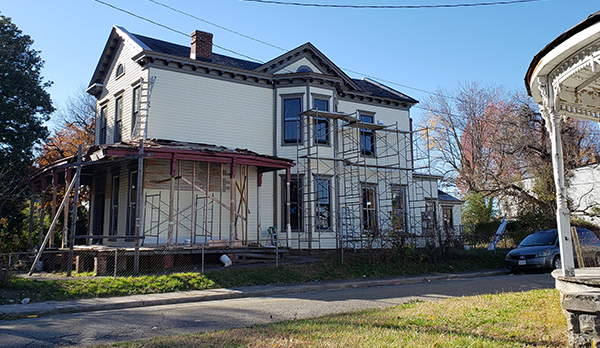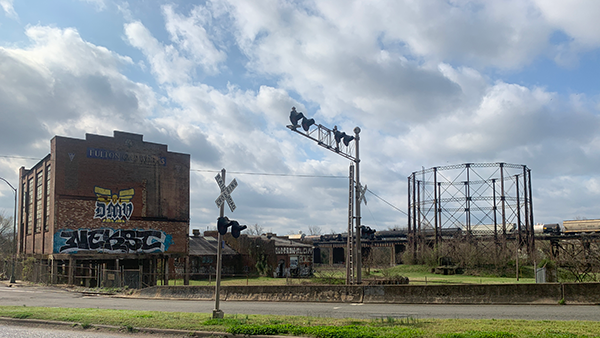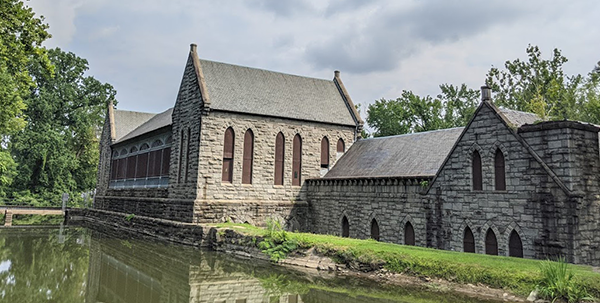2022 Year in Review

You know that Richmond is a really special place – full of unique and authentic people and places with lots of personality. Look through images of historic neighborhoods in the United States and it’s easy to identify New York City from Charleston from Miami from Richmond. Much of our city is easily distinguished by its porches, brick and slate buildings of 2-3 stories, large tree canopy, and connection of alleyways. Each of our historic districts and neighborhoods has a distinctive sense of place, with its own medley of public spaces, buildings, businesses, history and culture. Walking around these places, you know you are in Richmond - not in “Anywhere, USA.” We know it too, and that is why we are big cheerleaders for Richmond!
We hate to lose a historic building or place that is important to the community, particularly when it removes from the landscape a place that tells the story of Richmond. We work really hard, sometimes loudly, sometimes quietly behind the scenes, to see these places saved.
Here are some of our most exciting successes:
 Southern Barton Heights 4th home restoration in progress.
Southern Barton Heights 4th home restoration in progress.
- Southern Barton Heights Gateway Corridor Revitalization Project: We have completed three affordable home ownership opportunities with Project:HOMES and the Maggie Walker Community Land Trust, and are partnering with a private developer on a fourth house.
- National Register Listings: The preliminary information form prepared by a Historic Richmond volunteer for the listing of the historic Westwood neighborhood was advanced by DHR, and DHR is funding the nomination for Brookbury. We have been working to increase the number of listings associated with historically underrepresented groups and their histories, and also to highlight some of these stories through our lecture programs.
- Capitol Square: The rehabs of Old City Hall and Reid’s Row (formerly Morson’s Row) and the new General Assembly Building with its beautiful historic 1912 Life of Virginia façade are nearly complete. Our advocacy for these buildings and Capitol Square goes back decades and most recently helped to save the historic GAB façade and establish an expectation of high-quality historic rehabilitation projects. These were complicated projects and we congratulate the state for their extraordinary efforts to revitalize this most historic of public squares!
- Monumental Church: We have almost completed recoating the building with Keim and constructing a new ADA-compliant ramp at the west entrance. You can follow along with our work here.
- Neighborhoods: Guided by our new strategic plan, we are working to protect and preserve the historic places that make Richmond unique and authentic and to make preservation more accessible. Seeing several historic districts under pressure, we are experimenting with a pilot program for small façade grants to help “keep the neighborhood in the neighborhood.” To learn more about this effort, click here.
Here are a few where our efforts did not succeed:


- Fulton Gas Works: The City dismantled the historic Gasometer and demolished the remaining historic structures in order to remediate the site. Although our advocacy failed to save these structures from demolition, the City promised to re-erect the Gasometer when the environmental remediation project is complete.
- Richmond Public Schools: Already facing numerous challenges, RPS suffered a gut punch when fire significantly damaged the historic William Fox Elementary School. The community and Historic Richmond clamored for preservation. The good news is that RPS is reconstructing Fox. (Other historic RPS properties are also on the wire - Oak Grove Elementary is slated for redevelopment, while Thirteen Acres and Moore Street School are slated for RFPs - more on that below).
- City Center: City Council approved a rezoning of the City Center, which failed to protect the John Marshall House, despite months and years of advocacy by Historic Richmond and our preservation partners at Preservation Virginia. We have spent a lot of time on the City Center, urging an adaptive reuse of the Blues Armory and advocating for the neighborhood’s rare surviving historic fabric in various planning efforts. We are keeping our eye on the City’s RFP for redevelopment of this area and believe a revitalized Blues Armory could be a huge asset.
- Shockoe: The Weiman’s Bakery building was one of two contributing structures in the National Register Historic District demolished to make way for a 12-story apartment tower. Over the past several years, as the City works on a Shockoe Small Area Plan and as called for by the Richmond 300, we have been advocating for a demolition review policy.
- Fan/VCU: VCU demolished the former home of Sally Belle’s on West Grace Street to make way for a new dorm. Nearby, a private developer is demolishing 933 West Grace Street for a new low-rise mixed-use building. (The same developer owns a remarkable historic bank building in Main Street’s financial district, which we are hoping they will save.)
- Manchester: A number of projects and rezonings were approved by the City making way for demolitions in Manchester. These include the Southern States grain silos, an iconic structure on the Manchester riverfront, and several smaller structures in the former Caravati’s complex (though the largest of the Caravati’s buildings is slated for a rehab). Plant Zero - the historic rehab project that made Manchester cool way back in 2002 - will be demolished in the coming days to make way for a new seven-story building. Amid Manchester’s explosive growth and the increasing number of demolitions, we need to find a path to a community-oriented sense of place. (There is good news here with Studio Two Three’s acquisition of Dogtown Dance Theater.)
- Other Industrial Districts: Industrial areas near the Diamond are seeing similar types of redevelopment and demolitions (the Cobb Lumber complex, which once manufactured munitions on Hermitage Road, will be demolished), as are areas in Northside around Chamberlayne Avenue.
- Commission of Architectural Review: The City of Richmond’s Commission of Architectural Review’s decisions were overturned by City Council at least twice in 2022. The Commission and its staff work really hard to preserve and protect Richmond’s City Old and Historic Districts and we hate to see their decisions overturned.
- Neighborhoods: Homes in our historic neighborhoods are being demolished at a remarkable rate. For example, in the Museum District alone, we can easily name three demolitions in the pipeline this year - 3113 West Grace Street, 3301 Park Avenue, and 5 North Colonial Avenue.
You get the point, there have been a lot of demolitions this year! In many cases, these demolitions are to make way for housing – which we know is an urgent community need - but some of our most challenging situations involve demolitions to make way for – nothing. Joni Mitchell’s famous lyric that “they paved paradise to put up a parking lot” still rings true. Unless a property is located in a City Old and Historic District, there is no review of a proposed demolition in Richmond. We have received a lot of calls from community members concerned with so many demolitions in their neighborhoods. The Richmond 300 calls for such a process and we have been advocating for it to allow for consideration of community concerns.
It is not all bad! We want to give you the inside scoop, so you should know that, despite these losses, we see a lot of progress in saving some of Richmond’s most special places.

- Citywide Preservation Plan: For several years, we have been encouraging the City to develop a citywide preservation plan to better protect its irreplaceable historic and cultural resources. The City is to begin work on this plan this winter. This will be a wonderful opportunity for neighborhoods and communities to speak up about the historic places they believe are important. (Think about that demo review policy!)
- South Richmond Survey: DHR also largely completed a survey of South Richmond historic resources, a project with which we were involved and which we hope will help advance our understanding of an understudied part of the City.
- Byrd Park Pump House: Progress is being made in developing plans for rehabilitating this magical neo-gothic structure on the canals. Even better, the federal government recognized the significance of the Pump House and its rehabilitation with a $500,000 budget allocation. This is a really complicated project, but the support for a Pump House revitalization is increasing by the minute, so it is a project we are thinking creatively about it.
- Moore Street School: The Commonwealth of Virginia recognized the importance of saving this historic school in Carver with a $75,000 budget allocation. The state budget also created a new BIPOC Fund to help save historic resources important to Virginia’s Black Indigenous People of Color communities. Thank you to all of you for voicing your support for these state legislative items when we asked! We also are providing strategic and technical advice, and have committed financial support, to a grassroots community effort to adaptively reuse the Moore Street School. This effort will require lots of people to roll up their sleeves.
- Shockoe Hill African Burying Ground: In March, this site was formally listed on the National Register of Historic Places. In June, we celebrated at the site with the unveiling a DHR-sponsored historic marker. And we have committed resources for a Cultural Resources Plan for the site, which we expect the City to kick off next year. This site, which had been rendered largely invisible on the landscape, now looks to a better future, thanks to a lot of community advocates and the City!
- Masons’ Hall: With our seal the envelope project providing the catalyst and establishing preservation momentum, the Masons are working on additional restoration projects on their front doors and front steps. This is one of the most historic structures in Richmond and it is awesome to see its revitalization, both for it individually and for the Shockoe neighborhood.
- Winfree Cottage: The City plans to move this historic structure, which we helped to stabilize a few years ago, to a permanent location in Manchester. A big THANK YOU! to the City!
- Awesome Golden Hammer Nominees: We loved celebrating 12 Golden Hammer winning projects in October at one of the best parties in town! The nominated projects show the breadth and depth of the community who has rolled up their sleeves and put on their thinking caps to save some of Richmond’s most unique and authentic places – places like the Baker School, Regency Square Mall, a church in Oakwood-Chimborazo, a historic filling station, a Manchester warehouse, the Richmond Trust Company banking tower, two University of Richmond buildings (a former fraternity house and a Ralph Adams Cram-designed academic building), an Art Deco store on Grace Street, an educational building at St. Joseph’s Villa, the VMHC and the YWCA. All the nominated teams deserve congratulations for their creative and innovative efforts to save some of Richmond’s most extraordinary cultural resources. (Just like last year, we look forward to visiting some awesome Golden Hammer projects in next year’s Historic Richmond Quoit Club!)
- Many More! We are excited that a number of other historic properties are in the process of being rehabbed and revitalized, thanks to the efforts of local nonprofits and developers. We look forward to seeing these iconic structures – including the Scottish Rite Temple, the Byrd Theatre, the Mutual Building and the Ross Building, St Gertrude’s School, many of the former Eck Properties in the Fan, Douglas Development’s properties on the 200 block of East Broad Street – and others as rehab work launches and progresses next year.
Guided by our new strategic plan, adopted over the summer, we are focused on a number of other issues impacting Richmond’s historic built environment, including workforce development in the building trades, threats to historic cemeteries/burial grounds, historic neighborhoods, demolitions and development in Monroe Ward, development along the canals and riverfront and viewshed protections, and state and local policies and regulations impacting land use.
Thank you for caring about Richmond, its history and historic places!
All of us at Historic Richmond are deeply grateful to all our partners, volunteers, friends, donors and sponsors who contributed their time, talent and treasure to help us shape a brighter future for Richmond.
Your generosity and financial support are vital to help us preserve and protect the historic places that make Richmond unique and authentic. We hope you will take this opportunity to re-invest in our important work by making a gift today.
THANK YOU!
